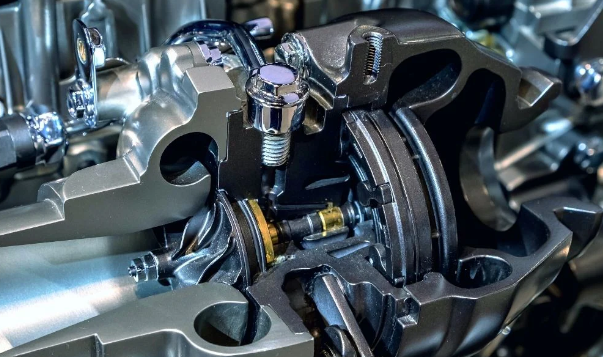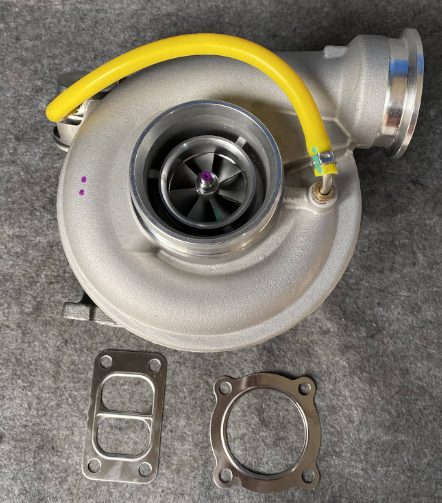Electric turbochargers are an advanced automotive technology that uses an electric motor to drive the compressor part of the turbocharger. Compared to traditional turbines driven by exhaust gases, electric turbochargers can provide faster boost response, thereby reducing the lag phenomenon of the turbocharger. This technology not only improves the efficiency and performance of the engine but also optimizes the engine’s efficiency across all speed ranges, improves fuel efficiency, and significantly increases power output. An E-Turbo typically consists of an electric motor, compressor, turbine, and power electronics, which work together to ensure that there is sufficient air in the combustion chamber, thereby increasing the engine’s power.
Turbochargers are forced induction devices that help the engine generate more power during combustion by drawing in more air. The motor air and fuel in the combustion chamber, the more powerful the combustion becomes. The turbine uses high-pressure exhaust gases to rotate the turbine, which in turn forces more air into the engine.
A turbocharger is a device that uses the exhaust gases emitted by the engine to drive a turbine, thereby increasing the intake air volume and improving the efficiency and power of the engine. An electric turbocharger adds an electric motor to assist or replace the exhaust-driven turbine.
A.Key Components and Their Functions in Electric Turbochargers
An electric turbocharger integrates multiple key components that work together to precisely control the intake-boosting process:
Motor: One of the core components of the electric turbocharger is the motor, which is responsible for converting electrical energy into mechanical energy to drive the compressor. Typically the motor adopts a high-performance permanent magnet synchronous motor, characterized by small size, lightweight, high efficiency, and large torque. It can quickly respond to control commands, providing ample power for the compressor.
Compressor: The compressor is responsible for drawing in air and compressing it to a preset pressure. To meet the requirements of the electric turbocharger for rapid response and a wide boost range, centrifugal or mixed-flow compressors are commonly used. These compressors are compact with small impeller diameters, capable of quickly establishing boost pressure at low speeds and continuously improving the boost effect as the speed increases.
Turbine: In some designs of electric turbochargers, a turbine is also included, which can use the exhaust energy of the engine to assist in driving the compressor, further improving the boost efficiency. The turbine usually adopts a small turbine, integrated with the compressor to form a compact “core” component.
Power Electronics System: The power electronics system is the control center of the electric turbocharger, responsible for precise control of the motor, compressor, and turbine. It includes sensors, controllers, drivers, and other components, capable of monitoring the system’s working state in real-time, and based on parameters such as engine speed, intake pressure, and exhaust temperature, accurately adjusting the motor power and turbine bypass valve opening to achieve the best boost control strategy.
Intercooler: The compressed air will heat up due to compression. To reduce the intake air temperature and improve the engine's intake efficiency, an intercooler is usually installed behind the electric turbocharger. Intercoolers typically use air-to-air or water-to-air forms and can effectively reduce the intake air temperature, providing cooler and denser air for the engine.
Intake and Exhaust Manifolds: Intake and exhaust manifolds are responsible for guiding air to the compressor, directing the compressed air into the engine's intake manifold, and guiding the exhaust gases to the turbine. To reduce flow resistance and improve efficiency, the manifolds are usually made of high-strength, heat-resistant aluminum alloy or composite materials, and equipped with necessary bends, throttle valves, and other components.
Sensors and Actuators: To achieve precise control, the electric turbocharger integrates a variety of sensors and actuators. Sensors include pressure sensors, temperature sensors, and speed sensors, responsible for monitoring the system's working state. Actuators include electric bypass valves, exhaust bypass valves, etc., responsible for adjusting the direction of airflow according to control commands.
Control Strategy: The control strategy of the electric turbocharger is the soul of the entire system, determining its efficiency and performance. The control strategy is usually implemented using an embedded system, capable of calculating the optimal boost pressure and timing in real-time based on engine conditions and environmental factors and sending commands to the power electronics system to control the operation of the motor, turbine, and bypass valves.
B.Working Principle of Electric Turbochargers
Electric turbochargers represent an innovative turbocharging technology that enhances the response speed and efficiency of turbocharging with the assistance of an electric motor. The detailed introduction to the working principle is as follows:
Demand Recognition: The engine control unit (ECU) determines the need for boosting based on the engine’s operating conditions, such as the position of the accelerator pedal and engine speed.
Motor Engagement: When the ECU detects a demand for boosting, it sends a signal to the control unit of the electric turbocharger to activate the motor.
Turbine Drive: The motor quickly starts and drives the rotation of the turbine shaft. One end of the shaft is connected to the compressor, and the other end is connected to the turbine. The involvement of the motor eliminates the traditional turbo lag because the motor can reach its maximum speed in a very short time.
Air Compression: As the turbine rotates, the compressor compresses the air entering the engine, increasing the air density and thus the intake volume.
Intercooling: Since compressed air generates heat, it needs to be cooled by an intercooler (such as a radiator) to reduce the intake air temperature and improve the intake efficiency and engine performance.
Boosted Air Delivery: The cooled, compressed air is delivered into the engine's intake manifold, where it mixes with fuel and enters the combustion chamber, enhancing combustion efficiency.
Energy Recovery: In some systems, the electric turbocharger can also function as a generator during deceleration or braking, converting kinetic energy into electrical energy to charge the vehicle's battery.
Intelligent Control: The control unit of the electric turbocharger monitors and adjusts the power output of the motor in real-time to adapt to different driving conditions and engine loads.
System Integration: Electric turbochargers are typically integrated with other engine control systems (such as fuel injection, ignition systems, etc.) to achieve optimal performance and efficiency.

C.Advantages of Electric Turbochargers
Rapid Response: One of the main advantages of electric turbochargers is their rapid response capability. Since the motor can start almost immediately, electric turbochargers can quickly provide a boost, eliminating the turbo lag phenomenon of traditional turbochargers at low speeds.
Improved Low-Speed Torque: As electric turbochargers can provide a boost at low engine speeds, they help increase torque output at low speeds, improving the vehicle's launch and acceleration performance.
Optimized Fuel Efficiency: By improving intake and combustion efficiency, electric turbochargers contribute to enhancing the overall fuel efficiency of the engine, thereby reducing fuel consumption and operating costs.
Emission Reduction: Improved combustion efficiency not only increases fuel efficiency but also reduces harmful emissions from incomplete combustion, helping to meet increasingly stringent emission standards.
Enhanced Driving Experience: Electric turbochargers provide smoother and more linear power output, reducing the abruptness that traditional turbochargers might bring, thus enhancing the driving experience.
Intelligent Control: Electric turbochargers are usually equipped with advanced electronic control units that can precisely adjust the boost level according to the engine's real-time demands, optimizing performance and efficiency.
Energy Recovery: In some configurations, the electric turbocharger can act as a generator during vehicle deceleration or braking, recovering energy and storing it in the battery for improved energy utilization efficiency.
Adaptability: Electric turbochargers can better adapt to different driving conditions and styles, providing optimal power output whether driving in the city or cruising at high speeds.
Technological Integration: As the automotive industry transitions towards electrification and intelligence, electric turbochargers can be seamlessly integrated with hybrid power systems, electric vehicles, and other advanced power management systems to provide more efficient and environmentally friendly solutions.
Reduced Maintenance Costs: Since electric turbochargers reduce reliance on traditional mechanical parts, they may lower long-term maintenance costs and complexity.
D.Disadvantages of Electric Turbochargers
High Cost: E-Turbos integrate motors, advanced control units, and complex sensors, which typically result in higher manufacturing costs than traditional turbochargers. This may lead to increased overall vehicle costs.
Technical Complexity: The control system of electric turbochargers is relatively complex, requiring precise software algorithms to manage the power output of the motor and the response of the turbine, increasing the technical difficulty of the system.
Maintenance and Repair Difficulty: Due to the complexity of electric turbochargers, their maintenance and repair may require specialized tools and trained technicians, potentially increasing maintenance costs and time.
Increased Weight: The addition of motors and other electronic components in electric turbochargers may make them heavier than traditional turbochargers, which could impact the vehicle's fuel efficiency and performance.
Thermal Management Issues: The motor and electronic control units of electric turbochargers generate heat under high loads, necessitating effective cooling measures to prevent performance and lifespan degradation.
Durability and Reliability: The durability and reliability of electric turbochargers need to be verified through long-term practical application, especially under extreme working conditions.
Energy Conversion Efficiency: Although electric turbochargers can improve response speed, there may be losses in energy conversion efficiency, potentially affecting overall fuel economy.
Technical Standardization and Compatibility: As a new technology, electric turbochargers lack unified industry standards, which may lead to compatibility issues between products from different manufacturers.
With ongoing technological development and industry experience accumulation, it is expected that more refined technical standards will emerge in the future to promote the standardization and regulation of electric turbocharger technology.
E.Applications of Electric Turbochargers
High-Performance Vehicles: These require rapid response and powerful power output. Electric turbochargers can provide instant boost effects, reducing turbo lag and enhancing acceleration performance.
Hybrid Electric Vehicles (HEVs): In hybrid systems, electric turbochargers can provide auxiliary power in electric mode and quickly supply boost when the engine starts, improving overall efficiency.
Plug-in Hybrid Electric Vehicles (PHEVs): They have high demands for power response in electric mode. Electric turbochargers can provide additional power support when powered by the battery.
Fuel Cell Electric Vehicles (FCEVs): FCEVs can utilize the rapid response of electric turbochargers to meet instantaneous power demands when extra power is needed.
Commercial Vehicles: Commercial vehicles such as trucks and buses need to maintain efficient power output under various loads and speeds. Electric turbochargers can improve the operational efficiency of these vehicles.

F.Market Prospects for Electric Turbochargers
Technological Innovation Driving Demand: Electric turbochargers have addressed the traditional turbo lag issue at low engine speeds through technological advancements. This technology significantly enhances the engine’s response and power performance, thereby meeting consumers’ demands for high-efficiency power systems.
Environmental Policy as a Catalyst: The global environmental pressure to reduce automotive exhaust emissions is increasing. Electric turbochargers, as a technology that improves engine efficiency and reduces emissions, comply with increasingly stringent environmental regulations and policies.
Growth in New Energy Vehicles: With the rapid development of the new energy vehicle market, particularly the proliferation of hybrid and plug-in hybrid vehicles, electric turbochargers, as a technology that integrates well with electrified vehicle models, are expected to see a further expansion in market demand.
Performance Benefits: Electric turbochargers offer immediate boost response, enhancing the driving experience. At high engine speeds, they can assist or replace the exhaust-driven turbine with an electric motor, increasing the engine’s rated power.
Policy Support: Governments have introduced policies, such as subsidies and tax incentives, to encourage and support the development of the turbocharger industry.
For inquiries or needs regarding E-turbo production, assembly lines, or equipment, please feel free to contact us for in-depth communication through the following channels:
Tel/Wechat/WhatsApp: +86 189 2373 2990
E-mail: sales@honest-hls.com
Linkedin: https://www.linkedin.com/company/honesthls/





